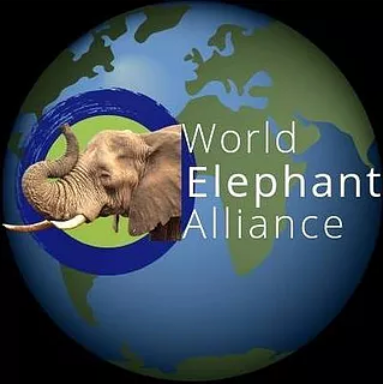African Elephant – A genus comprising two living elephant species, the African bush or also called savannah elephant and the smaller African forest elephant. Both are herbivores and live in groups. They have grey skin and differ in the size of their ears and tusks, and in the shape and size of their skulls. All African elephants, male and female, have tusks.
Genus Elephantidea
(African elephant) Loxodonta
- Species Loxodonta africana
- Subspecies Loxodonta africana africana(African bush elephant)
- Species Loxodonta cyclotis(African forest elephant) Native to humid forests in West Africa and the Congo Basin. It is the smallest of the three living elephant species, reaching a shoulder height of 2.4 m. Both sexes have straight, downpointing tusks, which erupt when they are 1–3 years old
Asian Elephant – Also called Asiatic elephant, a genus Elephas and is distributed throughout the Indian subcontinent and Southeast Asia, from India in the west, Nepal in the north, Sumatra in the south, and to Borneo in the east.
Genus Elephas
(Asiatic elephant) Elephas Maximus
- Subspecies Elephas maximus indicus(Indian elephant)
- Subspecies Elephas maximus maximus(Sri Lankan elephant)
- Subspecies Elephas maximus sumatranus(Sumatran elephant)
- Subspecies Elephas maximus borneensis(Borneo elephant or Asian pygmy elephant)
Ankus – A tool employed by elephant handlers in training of elephants.It’ made from bronze or steel – Consists of a hook with a handle ending in a tapered end.
Bullhook – A tool employed by elephant handlers in training of elephants.It’ made from bronze or steel – Consists of a hook with a handle ending in a tapered end.
Bull Elephant – An adult male elephant.
CITES – Convention on International Trade in Endangered Species is an international agreement between governments in the trade of wild animals and plants.
Conservation – A careful preservation and protection of something.
Trophy Hunting – Sport killing wildlife for human recreation. The trophy is a part of the wild animal kept as a symbol of success.
Culling – Controlling elephant populations by slaughtering.
Desert Elephant – Or Desert-adapted elephants are not a distinct species of elephant but are African bush elephants that have made their homes in the Namib and Sahara deserts. It was believed at one time that they were a subspecies of the African bush elephant but this is no longer thought to be the case.
Elephant – A thickset, usually extremely large, nearly hairless, herbivorous mammal (family Elephantidae, the elephant family) that has a snout elongated into a muscular trunk and two incisors in the upper jaw developed especially in the male into long ivory tusks.
Goad – A tool employed by elephant handlers in training of elephants. It’ made from bronze or steel consists of a hook with a handle ending in a tapered end.
Houda/Howdah – Seat or platform placed on the back of an elephant.
Ivory – The hard creamy-white modified dentine that composes the tusks of an elephant.
Jumbo – An elephant with tusks.
Mammoth – Any species of the extinct genus Mammuthus, one of the many genera that make up the order of trunked mammals called proboscideans. The various species of mammoth were commonly equipped with long, curved tusks and, in northern species, a covering of long hair.
Mastodon – Mastodons are any species of extinct proboscideans in the genus Mammut, distantly related to elephants that inhabited North and Central America during the late Miocene or late Pliocene up to their extinction at the end of the Pleistocene 10,000 to 11,000 years ago.
Musth – Periodic condition in bull elephants characterized by highly aggressive behavior and accompanied by a large rise in reproductive hormones.
Matriarchal Society – Matriarchy is a social system in which females (most notably in mammals) hold the primary power positions in roles of moral authority, social privilege, political authority and control of property. In matriarchal societies females hold higher status and hierarchical positions, leading the herd, family group, or society to optimal conditions for survival, such as clean water, fresh and nourishing food and environmental conditions.
Sanctuary – A place of safety.
Tusk – Elongated, continuously growing front teeth, usually but not always in pairs, that protrude well beyond the mouth of elephants.
Tusker – A male elephant with two normally developed tusks.
Woolly Mammoth – An extinct species of mammoth that lived during the Pleistocene until its extinction in the early Holocene epoch. It was one of the last in a line of mammoth species, beginning with Mammuthus subplanifrons in the early Pliocene.
Zoo – A facility with indoor and outdoor settings where living wild animals are kept for public exhibition, typically funded by tax payers through government, yet sometimes privately owned.
Works Cited: Wikipedia

